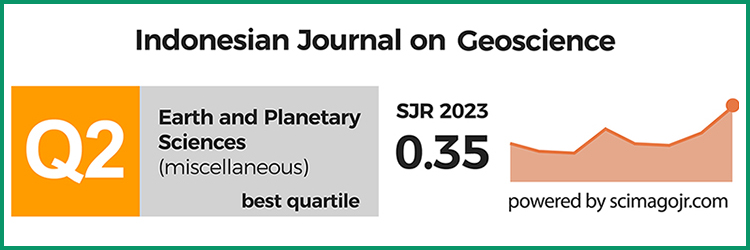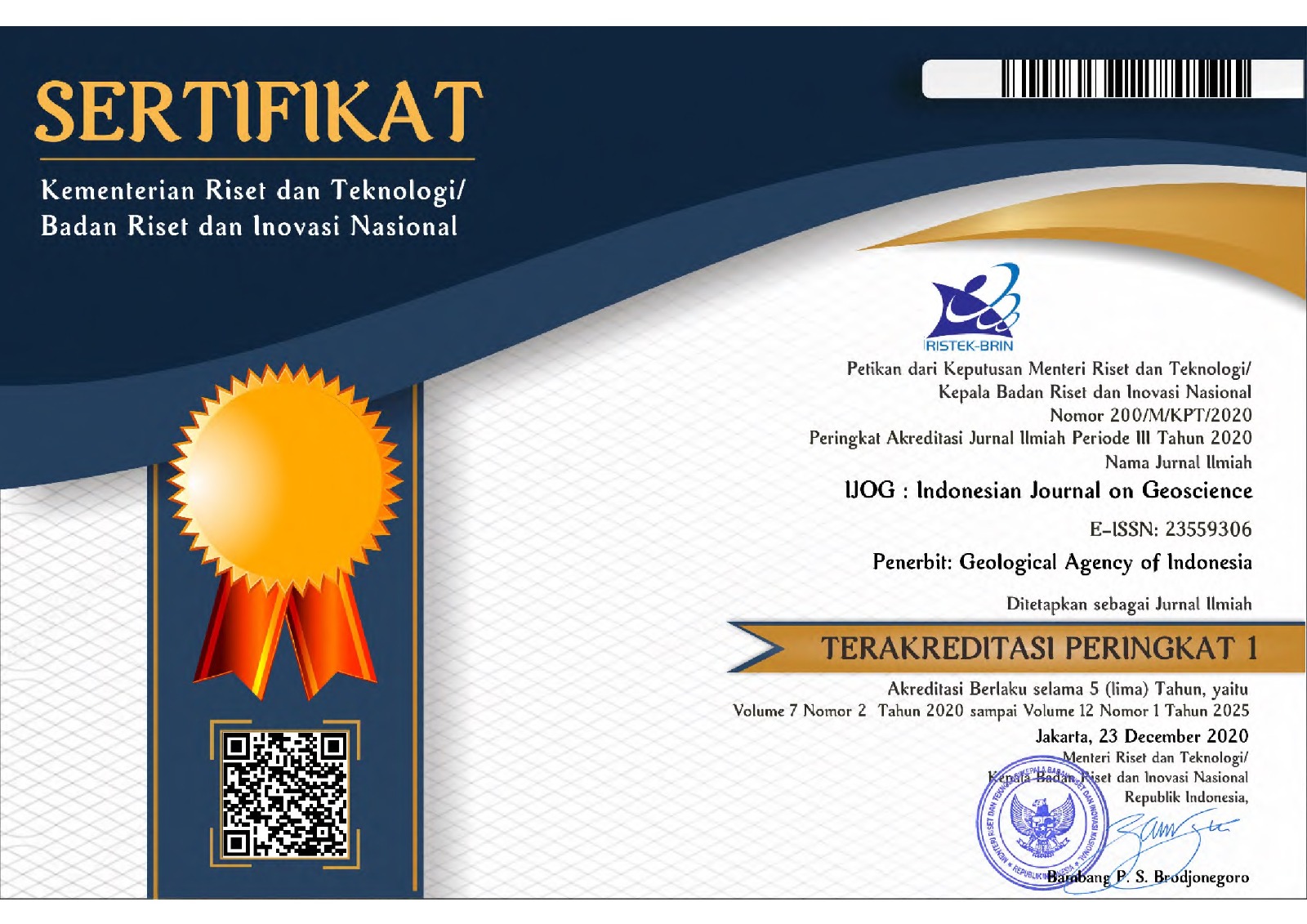Soil Infiltration Rate Prediction using Machine Learning Regression Model: A Case Study on Sepinggan River Basin, Balikpapan, Indonesia
DOI:
https://doi.org/10.17014/ijog.10.3.335-347Keywords:
Infiltration rate, multiple regression, machine learning, initial water contents, grain size, soilsAbstract
The infiltration rate of soil data is important in a wide range of planning, such as city planning, drainage design, landuse planning, flood prediction, flood disaster mitigation, etc. Collecting data of infiltration through in-site direct measurements is time consuming and costly. Indeed, inferring the infiltration rate using available parameters and the fittest model is needed. The model can shortcut the field measurement to get a predicted accurate infiltration rate that is worthy to support vital planning. This research aims to develop a model of infiltration rate based on initial water contents and grain size of soils. The results are three outstanding models based on the Multiple R Squared, Root Mean Square Error (RMSE), and Mean Average Error (MAE). The implication of the fittest model is reducing the cost and time to get the predicted infiltration rate. The field measurements can be skipped by sampling undisturbed soils and laboratory tests.
Keywords: infiltration rate, initial water contents, grain size
References
Alencoão, A.M.P. and Pacheco, F.A.L., 2006. Infiltration in the Corgo River basin (northern Portugal): coupling water balances with rainfall-runoff regressions on a monthly basis . Hydrological Sciences Journal, 51 (6), p.989-1005. https://doi.org/10.1623/hysj.51.6.989
Angulo-Jaramillo, R., Bagarello, V., Iovino, M., and Lassabatere, L., 2016. Infiltration Measurements for Soil Hydraulic Characterization. Springer International Publishing. DOI:10.1007/978-3-319-31788-5.
BAPPEDA Balikpapan, 2002. Kajian Geologi Untuk Evaluasi Penataan Wilayah dan Pengembangan Kota Balikpapan.
Bergeson, C.B., Martin, K.L., Doll, B., and Cutts, B.B., 2022. Soil infiltration rates are underestimated by models in an urban watershed in central North Carolina, USA. Journal of Environmental Management, 313, 115004. DOI:10.1016/j.jenvman.2022.115004.
Bhave, S. and Sreeja, P., 2013. ISH Journal of Hydraulic Engineering Influence of initial soil condition on infiltration characteristics determined using a disk infiltrometer Influence of initial soil condition on infiltration characteristics determined using a disk infiltrometer. DOI:10.1080/09715010.2013.808445.
Carslaw, D.C., 2019. The openair manual — opensource tools for analysing air pollution data. Manual for version 2.6-6, University of York. Dahan, O., Shani, Y., Enzel, Y., Yechieli, Y., and Yakirevich, A., 2007. Direct measurements of floodwater infiltration into shallow
alluvial aquifers. Journal of Hydrology, 344 (3-4), p.157-170. DOI: 10.1016/J.JHYDROL.2007.06.033.
Formansya, S., Gani, R.M., Firmansyah, Y., and Hermato, W., 2020. Sumberdaya Seam Batubara Formasi Pulau Balang di P.T. Anugerah Bara Kaltim, Kecamatan Loa Janan, Kabupaten Kutai Kartanegara, Kalimantan Timur. Padjadjaran Geoscience Journal, 4 (6). https://journal.unpad.ac.id/geoscience/article/view/32191/15018.
Fueki, N., Lipiec, J., Kuś, J., Kotowska, U., and Nosalewicz, A., 2012. Soil Science and Plant Nutrition Difference in infiltration and macropore between organic and conventional soil management. DOI:10.1080/00380768.2011.644759.
Hidayat, S. and Umar. I., 1994. Geological Map of The Balikpapan Quadrangle, Kalimantan, Scale 1 : 250.000. https://geologi.esdm.go.id/geomap/pages/preview/peta-geologi-lembarbalikpapan-kalimantan.
Juwita, R. and Santoso, I.B., 2019. Assessment of Soil Infiltration Capability in Balikpapan City. IPTEK Journal of Proceedings Series, 0 (5), p.291-297. DOI: 10.12962/ J23546026.Y2019I5.6341.
Khosravi, K., Ngo, P.T.T., Barzegar, R., Quilty, J.,Alami, M.T., and Bui, D.T., 2022. Comparing the Soil Conservation Service model with new machine learning algorithms for predicting cumulative infiltration in semi-arid regions. Pedosphere, 32, p.2-27.
Kiptiah, M., Azmanajaya, E., and Giarto, R.B., 2020. Analisis Laju Infiltrasi dengan Variasi Permukaan Tanah di Kota Balikpapan. Jurnal Sipil Sains, 10 (2), p.83-92. DOI:10.33387/SIPILSAINS.V10I2.2261.
Ma, J., Zeng, R., Yao, Y., Meng, X., Zhang, Z., Wang, H., and Zhao, S., 2022. Characterization and quantitative evaluation of preferential infiltration in loess, based on a soil column field test. CATENA, 213, 106164. DOI: 10.1016/J.CATENA.2022.106164.
McIntyre, D.S. and Sleeman, J.R., 1982. Macropores and hydraulic conductivity in a swelling soil. Soil Research, 20 (3), p.251-254. DOI:10.1071/SR9820251.
Michael, A.M., 2009. Irrigation : theory and practice. 768pp.
Muntohar, A.S., Ikhsan, J., Liao, H. J., Jotisankasa, A., and Jetten, V.G., 2022. Rainfall Infiltrationinduced Slope Instability of the Unsaturated Volcanic Residual Soils During Wet Seasons in Indonesia. Indonesian Journal on Geoscience, 9 (1), p.71-85. DOI:10.17014/ijog.9.1.71-85
Ruggenthaler, R., Meißl, G., Geitner, C., Leitinger, G., Endstrasser, N., and Schöberl, F., 2016. Investigating the impact of initial soil moisture conditions on total infiltration by using an adapted double-ring infiltrometer. Journal, 61 (7), p.1263-1279. DOI:10.1080/02626667.2015.1031758.
Setiawan, O., Sartohadi, J., Pramono Hadi, M., and Mardiatno, D.. 2019. Physical Geography Infiltration characterization using principal component analysis and K-means cluster analysis on quaternary volcanic landscape at the southern flank of Rinjani Volcano, Lombok Island, Indonesia. DOI: 10.1080/02723646.2019.1620526.
Sihag, P., Singh, V.P., Angelaki, A., Kumar, V., Sepahvand, A., and Golia, E., 2019. Model ling of infiltration using artificial intelligence techniques in semi-arid Iran. Hydrological Sciences Journal, 64 (13), p.1647-1658. DOI:10.1080/02626667.2019.1659965.
Sugianti, K., Yunarto, Sadisun, I.A., and Kartiko, R.D., 2022. Analysis of Maximum-Rainfall Infiltration Induced Slope Stability Using the Transient Rainfall Infiltration and Grid-based Regional Slope-stability Model in Cililin, West Java, Indonesia. Indonesian Journal on Geoscience, 9 (2), p.263-278. DOI: 10.17014/ijog.9.2.263-278
Sulistyo, T., 2003. Studi On Slope Stability In Vulnerable landslide Area For Evaluation Of General City Spatial Arrangement Plan In South Balikpapan [UPN “Veteran” Yogyakarta]. https://opac.upnyk.ac.id/libsysintegrasi/opac/index.php/home/detail_koleksi?kd_buku=00000000000000020017&id=1&title=Studi+On+Slope+Stability+In+Vulnerable+Landslide+Area+For+Evaluation+Of+General+City+Spatial+Arrangement+Plan+In+South+Balik+Papan&kd_jns_buku=SK.
Sulistyo, T., 2018. Identification Aquifer Parameters Through Single Well Pumping Test Series at PT. Kaltim Kariangau Terminal, Balikpapan, East Kalimantan. 3 (2), p.293-300.
Sulistyo, T. and Abrar, A., 2017. Characterization of Thin Alluvial Bed Aquifers in Manggar River Balikpapan East Kalimantan Indonesia. JTT (Jurnal Teknologi Terpadu), 5 (1), 54pp. DOI: 10.32487/jtt.v5i1.212.
Sy, N.L., 2006. Modelling the infiltration process with a multi-layer perceptron artificial neural network. Hydrological Sciences-JournalDes Sciences Hydrologiques, 1, 51pp. DOI:10.1623/hysj.51.1.3
Thomas, A.D., Austin, A., William, A., Eric, O.D., Alex, A.A., Maxwell, B., Isaac, L., Gilbert, A. A., and Duke, Q.N.D., 2022. Performance evaluation of infiltration models under different tillage operations in a tropical climate. Scientific African, 17, e01318. DOI:10.1016/J.SCIAF.2022.E01318.
Downloads
Published
Versions
- 23-11-2023 (2)
- 17-11-2023 (1)



















